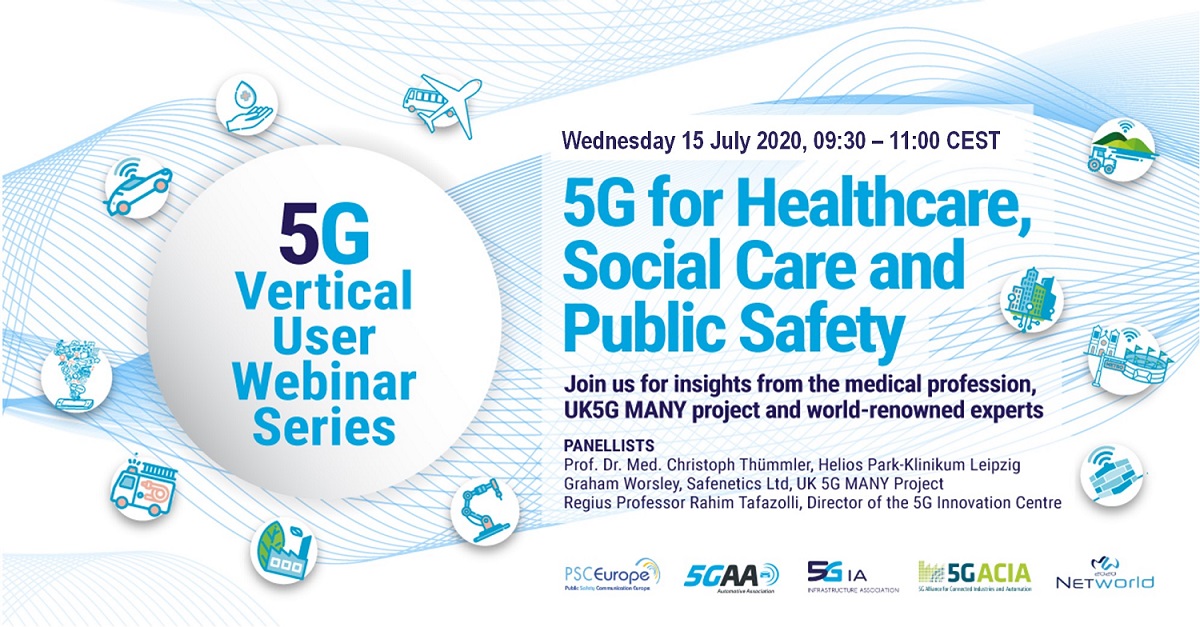
Outcomes of Webinar on 5G for Healthcare, Social Care and Public Safety
Health and social care have become highly topical in 2020 and are an extremely important safeguard in our society. As we move forward with our collaboration across industry verticals and standardisation, we have chosen to explore how we can use 5G standardised technologies to support health, social care and public service for every citizen, avoid major disasters and reducing the need for interventions by first responders.
Here's a brief report on the webinar covering these key topic as a first step towards defining priorities to drive 5G adoption and standardisation. The webinar on 15 July 2020 was the third in a series organised by a sub-set of 3GPP Market Representation Partners: 5G Automotive Association (5GAA), 5G Alliance for Connected Industry and Automation (5G-ACIA), 5G-Infrastructure Association (5G-IA), Public Safety Communication Europe (PSCE). This webinar was co-hosted with the European Technology Platform, NetWorld2020.
Presentations
Moderators: Dr Andreas Mueller, Bosch and Chair of 5G-ACIA. Stephanie Parker, Trust-IT and FULL5G Partner. Vice-chair of the 5G-IA Pre-Standardization Working Group. Welcome.
Dr David Lund, President of PSCE Announcement: Important progress has recently been made for Public Safety in Europe through the Horizon 2020 BroadWay project. Contracts have now been signed with supply teams for Pan-European public safety, building on the 3GPP mission-critical service layer. None of this would have been possible without the very hard work of the global standards community. Now, the challenge for Broadway and the supply teams on that with more considerations being made in this webinar for public safety with a view to supporting communities in rural and isolated areas.
Graham Worsley, Safenetics Ltd. Health, Social Care and Public Safety Use Cases in the UK5G MANY project (Mobile Access North Yorkshire)
Prof. Dr. Med. Christoph Thuemmler. A 5G Health Association
Regius Professor Rahim Tafazolli, Director Institute for Communication System (ICS), 5G Innovation Centre at University of Surrey. Universal eHealth, A technology perspective:
Takeaways
#1: Pressing need for a common, global standard for eHealth/mHealth.
The lack of a global standard has significantly slowed down the adoption of eHealth and mHealth over the past decade. An agreed, global standard would overcome adoption barriers and pave the way for integrated solutions that empower both healthcare professionals and patients.
#2: Bringing together awareness, collaboration, evidence and regulation
Basic connectivity issues, e.g. in rural areas, does not require 5G networks. However, there are many healthcare applications and services where only 5G can make a difference. With this in mind, we need stronger collaboration across the private and public sector, including SMEs. We also need greater awareness of 5G in the healthcare sector through education and training. Any solution for integrated, virtualised healthcare needs to prove that the system works. On top of this, we need harmonised regulations to level the playing field.
#3: 5G health risks and the global infodemic
The outbreak of COVID-19 has triggered huge amounts of misinformation, not only about the virus but also 5G. This infodemic and conspiracy theories are creating even greater barriers to adoption based on popularised misconceptions, including a lack of understanding about real and evidence-based privacy and security issues.
Regius Professor Rahim Tafazolli and colleagues at the University of Glasgow and Strathclyde have recently published a study with straightforward explanations to help clarify the misconceptions.
Busting the Myths About 5G – Facts Versus Fiction
#4: New 5G Health Association and Funding are key to filling the white spots in the sector.
The health sector is a prime example of how 5G can enable innovative applications in essential areas for citizens. This newly born association (5G health Association) seeks to address barriers to 5G uptake by matching the capability of 5G technology with the clinical needs and general conditions of biomedical and medical infomatics technologies. Please refer to the slide deck of Dr. Med. Christoph Thuemmler for more information on how to get involved.
Funding at national and EU levels is critical for driving forward innovations in the sector, filling current gaps in terms of demonstrations, trials and pilots.
#5: Forthcoming White Paper to shed new light on 5G for healthcare
The new white paper, 5G Health - The Need for 5G Technologies in the Healthcare Domain, will give key insights into and updates on why we need 5G for future healthcare, what makes 5G different from current technologies, how 5G can be used to manage hospitals and departments within them, offer post-discharge services, support emergency responders. The paper will also cover requirements and KPIs for medical applications.
Poll Results and Statistics
The webinar on 15 July 2020 attracted participants from 14 EU27 countries and 9 Non-EU27/global countries. Top EU27 countries are: Germany, Netherlands, France and Spain. Top non-EU27 country: UK.
Two live polls were launched during the webinar. Poll 1 asked participants to indicate the main barriers to 5G for healthcare, Social Care and Public Safety. The results show that privacy and security issues and strict regulations in the healthcare sectors are the top barriers. Poll 2 asked participants to select topics for future webinars. The results show a continued interest in webinars spanning diverse verticals with a webinar on 5G technology enablers, e.g. edge computing, network slicing being the top choice. You can view the statistics here.
Webinar Recording
The full webinar recording is available on the 5G PPP YouTube Channel here.



